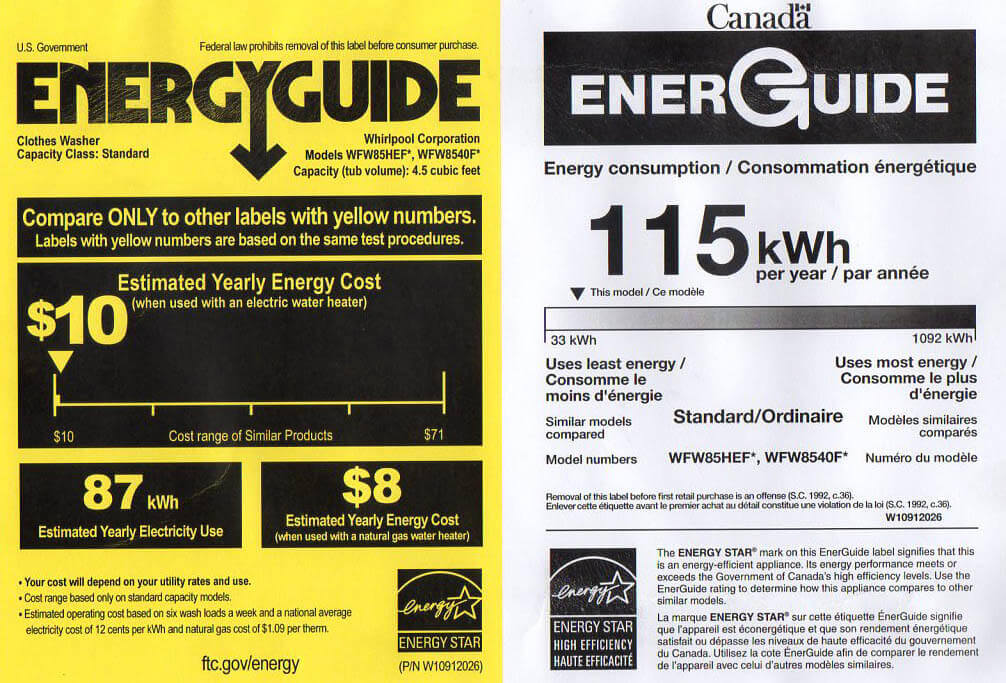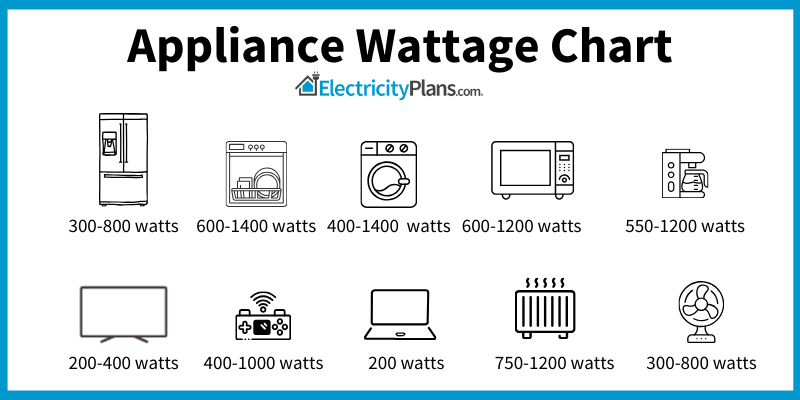When it comes to energy usage, not all appliances are created equal.
It makes sense to think of smaller appliances like coffee makers using less power than refrigerators and air conditioners, but there are even differences between models of the same machine. The individual differences might be small, but using the more economical versions can create savings of hundreds of dollars each year.
To understand what’s behind your electric bill or to make more informed choices as you shop around, learn more about which appliances use the most energy in your home and how to read their labels.
Understand Energy Usage Labels on Appliances
The Federal Trade Commission (FTC) created the Energy Labeling Rule, which requires manufacturers of certain appliances to disclose a product’s annual energy cost or efficiency information on EnergyGuide labels, and to report their findings to the FTC. The information must be based on Department of Energy (DOE) test procedures.
According to the Federal Trade Commission, the following appliances must have EnergyGuide labeling:
The Rule requires EnergyGuide labels for clothes washers, refrigerators, freezers, televisions, water heaters, dishwashers, room air conditioners, central air conditioners, furnaces, boilers, heat pumps, and pool heaters. Labeling requirements for certain light bulbs are explained here. The Rule also covers labeling for plumbing products and ceiling fans.
The rating tells you how much electricity the appliance uses when it’s running. For the appliances that fall within the EnergyGuide label requirements, the usage must be displayed visibly on the packaging. It must also be displayed in any catalog or website that sells the appliances. Here is an example of the U.S. Government’s Energyguide and Canada’s EnerGuide labels for a washing machine.

While energy efficiency isn’t the only factor you’ll use when choosing a new appliance, it can be an important one. All things being equal, buying the appliance with the more efficient energy rating will save you money during the life of the appliance.
The typical home uses over 50% of energy for heating and cooling, followed by water heating at almost 20% of energy usage. Appliances are a smaller part of your electricity bill than most people think. You can find more about energy usage in US homes in our article on that topic.
Average Electricity Usage of Household Appliances
As you might expect, the appliances that use the most power are almost all major installations, but some of them might surprise you.
Here are some of the worst culprits when it comes to using up power every hour (estimates based on average use):
- Central air conditioning (3 ton 12 SEER) can run at a rate of over 1000 kWh a month in the summertime. Consider a heat pump HVAC system for higher energy efficiency.
- An electric water heater can use over 400 kWh each month.
- Portable heaters can use an average of 365 kWh every month.
- A 2000 watt (2 horse power) swimming pool pump uses approximately 550 kWh every month. (You can cut this with a variable speed pool pump.)
Smaller appliances generally use less power, but upgraded design and energy efficiency keep some larger appliances from wasting too much power as well:
- Staying warm under a 200 watt electric blanket every night for 8 hours uses 48 kWh monthly.
- Cooling your room with a 35 watt ceiling fan for 8 hours daily uses 9 kWh monthly.
- Using your 1500 watt microwave oven every day for 6 minutes will use 4.5 kWh monthly.
- That mini-fridge in your office is usually between one and five cubic feet, and tends to fall between $20 and $40 per year in operating costs.
Calculate Electricity Usage for Appliances
You can calculate electricity usage (kWh) for your appliances with this formula:
(Watts x Hours Used) / 1000 = kWh
Or use our energy usage calculator tool:
Calculate electricity usage for your appliances.
| Wattage | |
| Hours Used Daily | |
| Energy Rate (¢/kWh) |
Your energy usage and cost for this appliance is :
| Usage | Cost | |
|---|---|---|
| Daily Usage | ||
| Monthly Usage | ||
| Annual Usage |
For reference, here is the typical wattage for common household appliances. Check the wattage label on your appliances for the most accurate calculation.

Do I Need to Replace My Appliances to Save on My Electric Bill?
The U.S. Department of Energy has created the ENERGY STAR program. This program rates appliances so consumers can learn about energy efficiency and usage.
When shopping for a new refrigerator or washing machine, check the ENERGY STAR rating to see how it holds up against other machines in the same category. The ENERGY STAR website has information on multiple appliances and gives recommendations for the most energy efficient examples of each one.
But if you’re not ready to buy a house full of new appliances, you can still save money by using your existing ones more efficiently. It’s possible to save money on almost every single electrical appliance you have in your home.
- Take a look at your thermostat. Be sure that your thermostat is on the same page as your schedule. Adjust it for the seasons and be sure to set it higher during your time away from home in warmer months. If you have multiple thermostats, set each zone to fit with your family’s schedule to avoid cooling an entire part of your house that’s unused. Travelling soon? Be sure to temporarily adjust your air conditioner accordingly.
- Insulation is your friend. Caulk around windows where drafts may come in, wrap insulation around water pipes underneath the house, and use draft dodgers in front of outside doors to keep cold air from coming in during the winter. The same advice holds true in summer when you want to keep the cool air inside and the hot air out.
- Never run your large appliances with partial loads. Wait a day or two until your dishwasher is completely filled, only do large loads of laundry, and air-dry clothes whenever possible. The same holds true for your oven. Combine cooking chores to bake multiple meals at the same time instead of heating up the oven three or four times during the week.
- Unplug appliances when you’re not actively using them. Appliances with a standby mode constantly drain power from your supply, whether you use them or not. These “energy vampires” can make a difference on your electric bill. Go through your house and disconnect them if they’re not being used. You can cut your electricity bill by simply making this one move.
- Get rid of the refrigerator in the garage. It’s common for the old refrigerator to find a new home in the garage. Don’t do that. First, the old appliance is not running as efficiently (or you wouldn’t have replaced it). Second, it will run even more inefficiently in a garage that isn’t air conditioned. Don’t believe us? Next time you unplug and thaw your old freezer, check your meter before you unplug it, then after you plug it back in.
Use this DIY home energy audit to find and fix energy waste in your home.
When choosing your electricity plan you’ll be faced with deciding your rate based on your average kilowatt-hour usage. There are always ways to keep that usage low by finding the most efficient way to use each appliance you have in your home.
